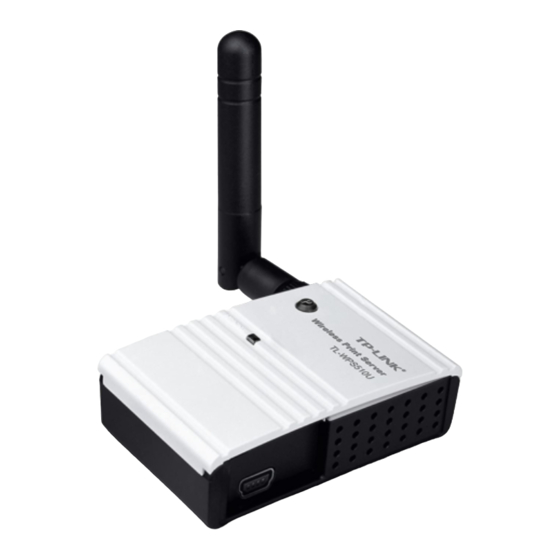
Summary of Contents for TP-Link TL-WPS510U
-
Page 1: Quick Installation Guide
Quick Installation Guide TL-WPS510U Pocket-sized Wireless Print Server Rev: 1.0.0 71065362... -
Page 2: Before You Start
1. Before you start, you should prepare the following items Windows 2000/XP/2003/Vista computer with print server setup CD USB Printer(non-GDI/CAPT) USB Printer cable One 802.11b/g Access Point (optional) 2. Wireless Network with Print Server Ad-Hoc mode (Peer to Peer) – Factory Default: Infrastructure mode (Access Point): 3. -
Page 3: Hardware Installation
IP Address: 192.168.0.10 Subnet Mask: 255.255.255.0 4. Hardware Installation Turn off the printer’s power. Connect the print server to your printer with the supplied printer cable. Turn the printer’s power on. Plug the AC power adapter into the power connector on the print server. Wait 40 seconds as part of the print server’s Power On Self Test (POST). -
Page 4: Software Installation
6. Software Installation 1) To enable network communication with print server, your computer must have a proper IP address, e.g. 192.168.0.100 (the print server’s default IP is 192.168.0.10) 2) Insert the setup CD into your CD-drive. The auto-run program will be started. - Page 5 5) From the Select A Print Server screen, select the print server port that you want to configure and click Next. 6) On the Change Settings screen, select No or Yes:...
- Page 6 Click No if you want the wireless print server to keep using the default IP address and the default settings: Username: admin Encryption: none Password: 0000 DHCP client: off Ad-Hoc mode IP address: 192.168.0.10 Channel: 1 Subnet Mask: 255.255.255.0 SSID: WLAN-PS Or click Yes if you want change wireless settings or assign a static IP address to the print server: On the Basic Wireless Settings screen, select Communication Type...
- Page 7 Note: The IP address of print server must be within the same subnet as your network adapter. 7) In the setup wizard, select an already configured printer from the list, click Next, Next and then Finish to complete the installation. Select Add New Printer if the print server is connected to a printer that hasn’t been installed before and does not appear in the list.
- Page 8 10) Make sure the Use the following port radio-button is clicked and select LPT1: (Recommended Printer Port) from the pull-down list. Then click Next. 11) Select Manufacturer and Printer from the lists of printer’s driver. Then click Next.
- Page 9 If you already have the printer’s driver installed, you will be asked whether to keep it or to replace it. Click Next. Supply a name for the printer and choose whether you want to make it your default printer. Then click Next. Then, choose whether you want to share the printer with other network users, print a test page (please select No.), etc.
- Page 10 Go to General; click Print Test Page to verify the configuration. Done. Note: If you wish to install more print servers, start setup wizard from your Windows Start menu: start All Programs Network Print Server Standard TCP/IP Printer Port PSWizard and repeat the installation procedure.
-
Page 11: Current Settings Of Print Server
How to create print server port manually? From your Windows Start menu: start All Programs Accessories System Tools Control Panel Hardware and Sound Printers. Find your installed printer icon, right-click, select Properties Ports Add Port Standard TCP/IP Port New Port Next. -
Page 12: Copyright And Trademarks
COPYRIGHT & TRADEMARKS Specifications are subject to change without notice. is a registered trademark of TP-LINK TECHNOLOGIES CO., LTD. Other brands and product names are trademarks of their respective holders. No part of the specifications may be reproduced in any form or by any means or used to make any derivative such as translation, transformation, or adaptation without permission from TP-LINK TECHNOLOGIES CO., LTD.















